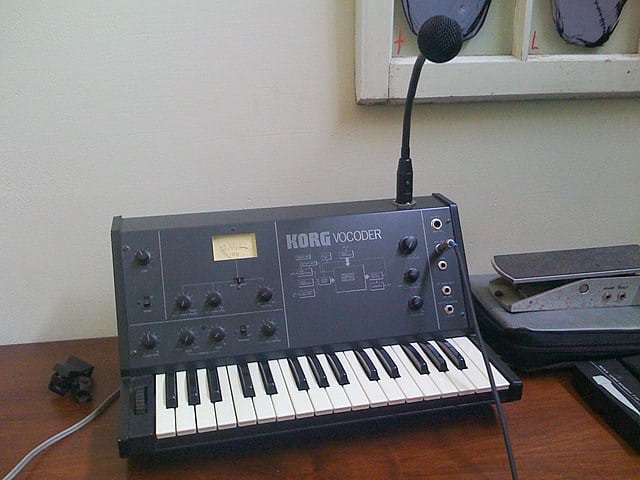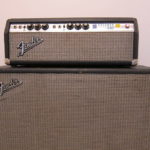Vocal manipulation has become an increasingly popular technique in music production and in live performance depending on the instrument used, usually the human voice.
There are many possible methods of manipulating the voice to sound drastically less human to better suit the style of music including vocoders, talkboxes, and autotune.
The main differences between Autotune, Talkbox, and Vocoder are how they work and how they sound. Autotune is a post-production plugin, talkbox sends instrument sound to your mouth so you can modulate into a mic, and vocoder is a synthesizer that uses your voice as a reference to filter the sound.
All of these methods can sound quite similar to each other but can also be quite distinct from each other depending on how they are used and applied to the music, given their unique sounds.
What is a Vocoder?
A vocoder is a technique that synthesizes the human voice and transforms it into code. This technique requires two audio sources: the human voice is usually the initial sound for a vocoder, this would be referred to as the ‘carrier’.
The other is a ‘modulator’ which manipulates the sound of the carrier which is often a MIDI keyboard with a vocoder function built-in.
The modulator signal is analyzed by a ‘filter bank’, it splits into multiple frequency bands and then a band-pass filter is then applied to each frequency band. The filters are then matched with the center frequency of each frequency band in the modulator.
The carrier (human voice) would go through the filters and the vocoder adjusts the level of each filter depending on the harmonics of the modulator which is basically the notes of the keyboard.
Here is a video of someone covering songs that uses the vocoder technique.
What is a Talkbox?
The talkbox is a small device that usually consists of a box (similarly sized to a medium-sized guitar pedal) that contains a speaker that feeds into a long plastic tube that would be held in the player’s mouth. The speaker connects to a guitar amplifier and in turn changes the sound from the instrument.
While sound flows through the plastic tube, the player has to use their mouth to shape the sound without being vocally aloud so that the microphone in front of the player, only picks up what is coming from the tube and not the player’s mouth.
The player’s mouth only needs to manipulate the sound to sound like human words by making ‘ah’, ‘oh, ‘ee’ type mouth movements.
Here is a video from Karl Golden Music showing songs that use a talkbox.
What is Autotune?
Autotune is pitch-correction software that is likely used in the majority of records being released today. Its function is to improve a vocalist’s recordings by adjusting incorrect pitches and removing any imperfections to better fit the mix. It can also be used extremely to create very robotic sounds.
Autotune works very simply. An input signal (vocalist) would have to go through the autotune software and be analyzed thoroughly so that the software can detect any moments where a note may be too flat or too sharp, and then corrects it to become perfect.
Autotune can come in many shapes and forms in various digital audio workstations but the main common parameter will allow you to view each note of the input signal and adjust it specifically rather than letting the software complete an automatic scan and adjust function.
Here is a video by Tom Scott that explains how autotune works while playing a song showing how it sounds.
What are the main differences between Vocoder, Talkbox, and Autotune?
Though all these vocal manipulation techniques can sound quite similar, they each work quite differently and have their own distinct sound. Unlike the talkbox and autotune, the vocoder is synth-based and requires an input signal to work. It also does not quite reproduce the same mouth movements as well as a talkbox.
Rather than using an input signal, the talkbox takes an input signal through a speaker and comes back through the plastic tube into a microphone while the player’s mouth filters the sound from the tube.
Autotune is the most different from a vocoder and talkbox, they both require a physical device while autotune is digital software that applies post-processing to a vocals input track.
It can also be applied drastically and massively change the vocals from subtle pitch correction to a full-on robot sound whereas the vocoder and talkbox effects do not have as much flexibility in terms of parameter adjustment.
Can any of these be used on guitar or other instruments?
Autotune can only be used on vocals but a talkbox is the common use for guitar and synth keyboards.
There is a small difference in sound between the guitar and synth for a talkbox but they tend to sound quite similar, the main difference is the guitar has a lot more human articulations compared to a keyboard, such as sliding, hammer-ons, harmonics, mutes, etc.
Well-known songs that use a talkbox with a guitar include “Livin’ On A Prayer” by Bon Jovi, “Kickstart My Heart” by Mötley Crüe, and “Beverly Hills” by Weezer.
A vocoder could be used on a guitar but it is not a very common technique.
One modern use is by Tim Henson in his songs ‘Nasty’ and ‘OD’. He uses a multi-voicer type vocoder on Ableton to use his guitar to trigger MIDI notes and allows him to play the dry guitar signal over a chordal vocoded guitar.
Here is a link showing how Tim Henson uses this technique:
Which of these effects might be better for you?
- If you are a music producer working with a lot of bands, especially vocalists, then autotune will be the most useful to you. This will allow you to improve the recordings of your clients and produce professional standard results.
- If you are an experienced guitar player who is beginning to feel bored of your current pedal collection and library of sounds, a talkbox will likely be a fun adventure for you. It is a very unique sound to add to your rig and you could take center stage without the worry of sounding vocally out of tune.
- If you are a producer and a keyboard player but want to experience a wider range of sounds, play around with the vocoder. There are many applications for different styles of music with the vocoder and could easily benefit you as a producer or a keys player.

Hello there, my name is Ramiro and I’ve been playing guitar for almost 20 years. I’m obsessed with everything gear-related and I thought it might be worth sharing it. From guitars, pedals, amps, and synths to studio gear and production tips, I hope you find what I post here useful, and I’ll try my best to keep it entertaining also.





